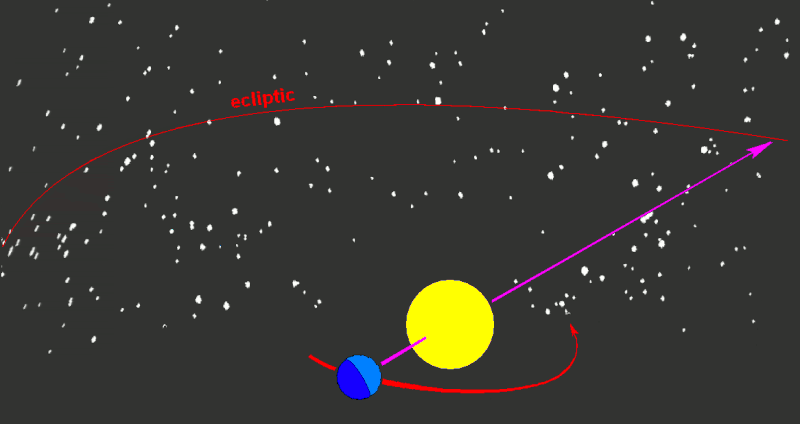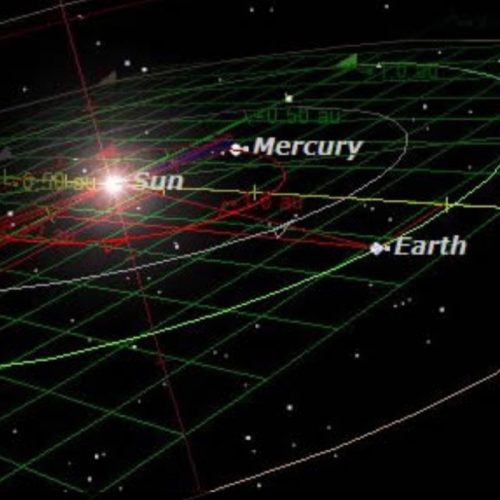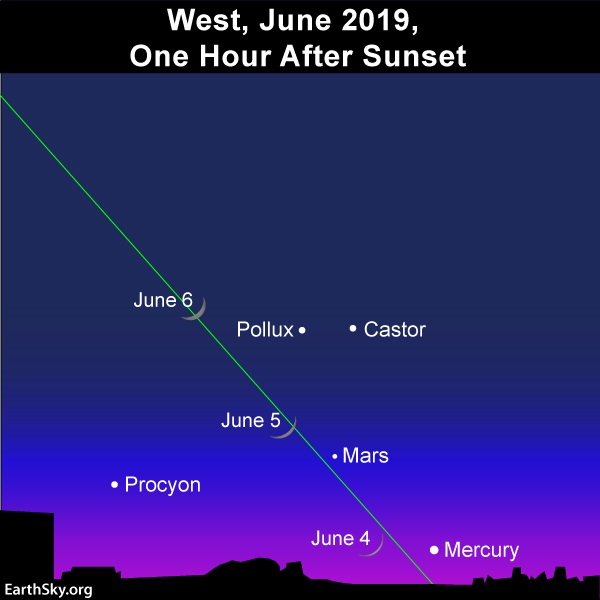

Animated depiction of Earth (the blue ball) orbiting the sun (the yellow ball), showing the projection of Earth-sun plane – the ecliptic – onto the background stars. Image via Tfr000/Wikimedia Commons.
Have you ever noticed that the sun, moon and planets all follow more or less the same path across our sky? Unless you live at or near a high Arctic or Antarctic latitude, you’ll never find the sun or moon due north, or due south, near your horizon. Instead, most of us on Earth see objects in our solar system crossing from the eastern to the western sky, as Earth spins, each day. If you get a chance to look for the bright planets when they’re all in the sky at the same time – as happens every year or so – you’ll see the visible planets trace out an easily observed line from the eastern to western horizon. It’s the same path the sun takes each day across our sky. This imaginary line, the path of the sun, is called the ecliptic.
Technically speaking, the Earth’s orbit defines the ecliptic. As viewed from space, the ecliptic is the Earth-sun plane. As viewed from Earth, the ecliptic is a great circle around our sky, formed by the intersection of Earth’s orbital plane with the imaginary celestial sphere surrounding us.
The sun travels around our sky on the great circle of the ecliptic. The moon and planets do, too, more or less. Why? It’s mainly because, long ago, before there was a solar system as we know it today, there was a vast cloud of gas and dust in space. This cloud was spinning, and, as it spun, it flattened out. Our sun formed in the center of this cloud, and the major planets and most other solar system objects formed in the flat disk surrounding the sun.

The ecliptic is defined by the plane of Earth’s orbit around the sun. The major planets in our solar system, and some asteroids, orbit more or less in this same plane. Image via Pics-about-Space.com.

Maybe you’ve noticed the green line on many of the charts in EarthSky’s Tonight pages. That green line marks the location of the ecliptic in our sky. Read more about the view June 4-6, 2019. Note that the angle of the ecliptic with respect to your horizon varies seasonally, and from place to place on Earth.
Today, we still see the major planets – and many of the minor planets aka asteroids – orbiting the sun approximately in this same plane, the plane of Earth’s orbit around the sun: the ecliptic. If we could watch the solar system from far above the Earth’s north pole, we’d see the planets, moons, asteroids, and some of the comets (but not all of them) rushing around the sun counterclockwise in this plane, like marbles rolling around a dish. Actually, the major planets are more within the dish than on it. They’re within the plane of the ecliptic, more or less. They retain the outline of the original cloud in space from which they were born, and their movement around the sun is an echo of the original spin of the cloud.
Since we’re in that plane, too – within the dish – we look into our sky to see edgewise into the plane of the solar system. And so we see these solar system objects travel along the ecliptic, the sun’s path, more or less.
Moon and planets on October 12, 2016, by Karthik Easvur in Hyderabad, India. The moon and planets trace out a line across our sky because they all orbit the sun, more or less, in a single plane. And – as seen from Earth – we look edgewise into that flat plane of the solar system.
Far beyond the cold edges of our solar system, we see the stars of our Milky Way galaxy. The stars are moving, too, but they’re so far away that they don’t seem to move over the course of a human lifespan. And so we speak of the “fixed” stars. Fixed stars on the ecliptic – or sun’s path – seemed special to the early stargazers. They identified constellations made of these stars, and used the word zodiac for the wider pathway traveled by these constellations. And so we find the sun, moon and our major planets within the constellations of the zodiac.
Now about that phrase we keep using, the phrase more or less …
The other planets don’t orbit exactly in the Earth-sun plane. Each major planet’s orbit is inclined a little bit to this plane. Some of the asteroids have orbits that are more inclined. And comets tend to have the most inclined orbits of all. Click here to see the inclinations of the major planets’ orbits.
Interestingly, Earth’s moon isn’t exactly on the ecliptic, either. Its orbit around Earth is tilted by about 5.15 degrees relative to the ecliptic. This means the moon spends most of its time above or below the ecliptic. It crosses it twice each orbit; once going upward and once downward from our point of view. We usually see the moon close to, but not exactly alongside the other solar system objects. On the other hand, the moon sometimes passes right in front of other solar system objects, in an event called an occultation.
So there are little variations. But – for all practical purposes of skywatching – you can think of the ecliptic as a line across our sky. You can think of the sun, moon and major planets of the solar system as moving along that line. One thing to remember, though. The sun’s path is high in summer and low in winter. So the location of the ecliptic in your sky shifts a bit, seasonally.

The ecliptic on June 21, 2019, and December 21, 2019. Image from Stellarium,
If the word ecliptic sounds familiar, you’re right. It’s from the same root as the word eclipse, from the Latin and Greek meaning to “fail to appear” or “to be hidden;” the moon hides the sun during an eclipse. The ecliptic got its name because the ancients saw that solar eclipses happen when the moon crosses the ecliptic during the new moon phase.
Later, astronomers gave the name node to the places where the moon crosses the ecliptic. If the moon traveled exactly on the ecliptic, and the other planets did, too, the moon would occult, or block out, all the planets and the sun every orbit. We’d have lunar and solar eclipses every month. Ho hum.
If you’re able, keep an eye on the sun, the moon and the planets for a while; a few days, a few weeks, months, years, even. You’ll begin to get a feel for the ecliptic in your sky. You’ll notice the planets, sun and moon are always on or near the ecliptic, and you can use this line across your sky to help you find your way around, making your way between the constellations and stars. You’ll notice the sun’s path – the ecliptic – higher in the sky during the summer months and lower during the winter. Eventually, you’ll be able to imagine the sun’s path in your sky, long after the sun has set.
When that happens, you’ll be able to pick out a planet from a star very quickly and easily, which is a great party trick. Mars is the red one; Saturn the yellow one; Venus the bright white one that never gets too far from the sun; Mercury the seldom-seen one; and Jupiter the very bright one (but never as bright as Venus) that often gets far from the sun.
Welcome to stargazing, friend!

View larger. | The cameras of the Voyager 1 spacecraft acquired the images to create this mosaic on February 14, 1990, as it journeyed out of the solar system. It pointed back toward the sun and took this series of pictures of our sun and several major planets, making the first-ever “portrait” of our solar system as seen from the outside. The mosaic consists of a total of 60 frames. Voyager 1 was at a distance of approximately 4 billion miles and about 32 degrees above the ecliptic plane. Read more about this image via NASA PhotoJournal.
Bottom Line: The ecliptic is the path the sun takes across our sky. It’s the Earth-sun plane, and, more or less, the plane of our solar system. Stargazing tip: Learn the whereabouts of the ecliptic in your sky. You’ll always find the sun, moon and planets on or near it.
from EarthSky http://bit.ly/2Kmtjvn


Animated depiction of Earth (the blue ball) orbiting the sun (the yellow ball), showing the projection of Earth-sun plane – the ecliptic – onto the background stars. Image via Tfr000/Wikimedia Commons.
Have you ever noticed that the sun, moon and planets all follow more or less the same path across our sky? Unless you live at or near a high Arctic or Antarctic latitude, you’ll never find the sun or moon due north, or due south, near your horizon. Instead, most of us on Earth see objects in our solar system crossing from the eastern to the western sky, as Earth spins, each day. If you get a chance to look for the bright planets when they’re all in the sky at the same time – as happens every year or so – you’ll see the visible planets trace out an easily observed line from the eastern to western horizon. It’s the same path the sun takes each day across our sky. This imaginary line, the path of the sun, is called the ecliptic.
Technically speaking, the Earth’s orbit defines the ecliptic. As viewed from space, the ecliptic is the Earth-sun plane. As viewed from Earth, the ecliptic is a great circle around our sky, formed by the intersection of Earth’s orbital plane with the imaginary celestial sphere surrounding us.
The sun travels around our sky on the great circle of the ecliptic. The moon and planets do, too, more or less. Why? It’s mainly because, long ago, before there was a solar system as we know it today, there was a vast cloud of gas and dust in space. This cloud was spinning, and, as it spun, it flattened out. Our sun formed in the center of this cloud, and the major planets and most other solar system objects formed in the flat disk surrounding the sun.

The ecliptic is defined by the plane of Earth’s orbit around the sun. The major planets in our solar system, and some asteroids, orbit more or less in this same plane. Image via Pics-about-Space.com.

Maybe you’ve noticed the green line on many of the charts in EarthSky’s Tonight pages. That green line marks the location of the ecliptic in our sky. Read more about the view June 4-6, 2019. Note that the angle of the ecliptic with respect to your horizon varies seasonally, and from place to place on Earth.
Today, we still see the major planets – and many of the minor planets aka asteroids – orbiting the sun approximately in this same plane, the plane of Earth’s orbit around the sun: the ecliptic. If we could watch the solar system from far above the Earth’s north pole, we’d see the planets, moons, asteroids, and some of the comets (but not all of them) rushing around the sun counterclockwise in this plane, like marbles rolling around a dish. Actually, the major planets are more within the dish than on it. They’re within the plane of the ecliptic, more or less. They retain the outline of the original cloud in space from which they were born, and their movement around the sun is an echo of the original spin of the cloud.
Since we’re in that plane, too – within the dish – we look into our sky to see edgewise into the plane of the solar system. And so we see these solar system objects travel along the ecliptic, the sun’s path, more or less.
Moon and planets on October 12, 2016, by Karthik Easvur in Hyderabad, India. The moon and planets trace out a line across our sky because they all orbit the sun, more or less, in a single plane. And – as seen from Earth – we look edgewise into that flat plane of the solar system.
Far beyond the cold edges of our solar system, we see the stars of our Milky Way galaxy. The stars are moving, too, but they’re so far away that they don’t seem to move over the course of a human lifespan. And so we speak of the “fixed” stars. Fixed stars on the ecliptic – or sun’s path – seemed special to the early stargazers. They identified constellations made of these stars, and used the word zodiac for the wider pathway traveled by these constellations. And so we find the sun, moon and our major planets within the constellations of the zodiac.
Now about that phrase we keep using, the phrase more or less …
The other planets don’t orbit exactly in the Earth-sun plane. Each major planet’s orbit is inclined a little bit to this plane. Some of the asteroids have orbits that are more inclined. And comets tend to have the most inclined orbits of all. Click here to see the inclinations of the major planets’ orbits.
Interestingly, Earth’s moon isn’t exactly on the ecliptic, either. Its orbit around Earth is tilted by about 5.15 degrees relative to the ecliptic. This means the moon spends most of its time above or below the ecliptic. It crosses it twice each orbit; once going upward and once downward from our point of view. We usually see the moon close to, but not exactly alongside the other solar system objects. On the other hand, the moon sometimes passes right in front of other solar system objects, in an event called an occultation.
So there are little variations. But – for all practical purposes of skywatching – you can think of the ecliptic as a line across our sky. You can think of the sun, moon and major planets of the solar system as moving along that line. One thing to remember, though. The sun’s path is high in summer and low in winter. So the location of the ecliptic in your sky shifts a bit, seasonally.

The ecliptic on June 21, 2019, and December 21, 2019. Image from Stellarium,
If the word ecliptic sounds familiar, you’re right. It’s from the same root as the word eclipse, from the Latin and Greek meaning to “fail to appear” or “to be hidden;” the moon hides the sun during an eclipse. The ecliptic got its name because the ancients saw that solar eclipses happen when the moon crosses the ecliptic during the new moon phase.
Later, astronomers gave the name node to the places where the moon crosses the ecliptic. If the moon traveled exactly on the ecliptic, and the other planets did, too, the moon would occult, or block out, all the planets and the sun every orbit. We’d have lunar and solar eclipses every month. Ho hum.
If you’re able, keep an eye on the sun, the moon and the planets for a while; a few days, a few weeks, months, years, even. You’ll begin to get a feel for the ecliptic in your sky. You’ll notice the planets, sun and moon are always on or near the ecliptic, and you can use this line across your sky to help you find your way around, making your way between the constellations and stars. You’ll notice the sun’s path – the ecliptic – higher in the sky during the summer months and lower during the winter. Eventually, you’ll be able to imagine the sun’s path in your sky, long after the sun has set.
When that happens, you’ll be able to pick out a planet from a star very quickly and easily, which is a great party trick. Mars is the red one; Saturn the yellow one; Venus the bright white one that never gets too far from the sun; Mercury the seldom-seen one; and Jupiter the very bright one (but never as bright as Venus) that often gets far from the sun.
Welcome to stargazing, friend!

View larger. | The cameras of the Voyager 1 spacecraft acquired the images to create this mosaic on February 14, 1990, as it journeyed out of the solar system. It pointed back toward the sun and took this series of pictures of our sun and several major planets, making the first-ever “portrait” of our solar system as seen from the outside. The mosaic consists of a total of 60 frames. Voyager 1 was at a distance of approximately 4 billion miles and about 32 degrees above the ecliptic plane. Read more about this image via NASA PhotoJournal.
Bottom Line: The ecliptic is the path the sun takes across our sky. It’s the Earth-sun plane, and, more or less, the plane of our solar system. Stargazing tip: Learn the whereabouts of the ecliptic in your sky. You’ll always find the sun, moon and planets on or near it.
from EarthSky http://bit.ly/2Kmtjvn

Aucun commentaire:
Enregistrer un commentaire